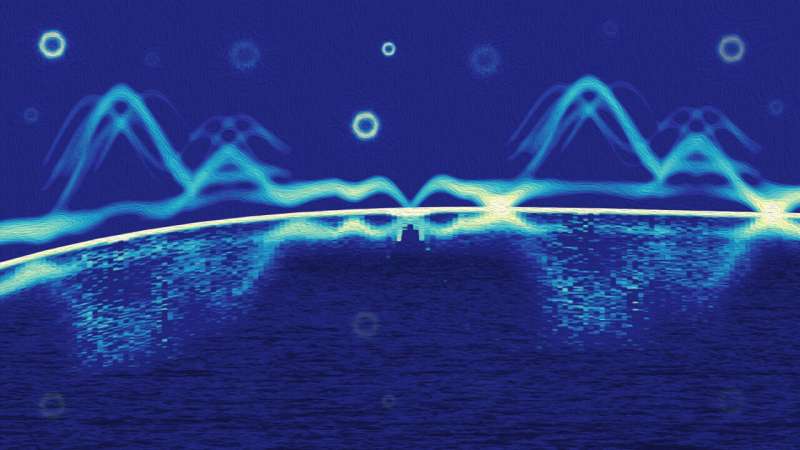Neutron scattering revealed spin correlations of iron trichloride. An artist’s image interprets the scattering that provides evidence of a spiral spin-fluid state. Credit: Jacquelyn DeMink/ORNL
Scientists at Oak Ridge National Laboratory used neutron scattering to determine whether the atomic structure of a specific material could contain a new state of matter called a spiral spinning fluid. By tracking tiny magnetic moments known as “spins” on the honeycomb lattice of a layered iron trichloride magnet, the team found the first 2D system involving a spiral spinning fluid.
The discovery provides a testbed for future studies of physical phenomena that could power the next generation of information technologies. These include fractons, or collective quantized vibrations that may hold promise in quantum computing, and skyrmions, or novel magnetic spin textures that could promote high-density data storage.
“Materials containing spiral spin fluids are particularly exciting because of their potential to be used to generate quantum spin fluids, spin textures and fractone excitations,” said ORNL’s Shang Gao, who led the study published in Physical Assessment Letters.
A long-held theory predicted that the honeycomb lattice may contain a spiral spinning fluid — a new phase of matter in which spins form fluctuating corkscrew-like structures.
But until the current study, experimental evidence of this phase in a 2D system was lacking. A 2D system consists of a layered crystalline material in which the interactions in the planar direction are stronger than in the stacking direction.
Gao identified ferric trichloride as a promising platform for testing the theory, which was proposed more than a decade ago. He and co-author Andrew Christianson of ORNL approached Michael McGuire, also of ORNL, who has worked extensively on culturing and studying 2D materials, asking whether he would synthesize and characterize a sample of ferric trichloride for neutron diffraction measurements. Just as 2D graphene layers in bulk graphite exist as honeycomb lattices of pure carbon, 2D iron layers in bulk iron trichloride exist as 2D honeycomb layers. “Previous reports have hinted that this interesting honeycomb material could exhibit complex magnetic behavior at low temperatures,” McGuire said.
“Each honeycomb layer of iron has chlorine atoms above and below it, creating chlorine-iron-chlorine plates,” McGuire said. “The chlorine atoms on top of one plate interact very weakly with the chlorine atoms on the bottom of the next plate through van der Waals bonding. This weak bond allows materials like this to be easily separated into very thin layers, often into a single slab. This is useful for developing devices and understanding the evolution of quantum physics from three dimensions to two dimensions.”
In quantum materials, electron spins can behave collectively and exotically. When one spider moves, they all react — an entangled state that Einstein called “spooky action at a distance.” The system remains in a state of frustration – a fluid that perpetuates disorder as electron spins constantly change direction, forcing other entangled electrons to fluctuate in response.
The first neutron diffraction studies of ferric chloride crystals were performed at ORNL 60 years ago. Today, ORNL’s extensive expertise in materials synthesis, imaging, neutron scattering, theory, simulation, and computation enables groundbreaking explorations of magnetic quantum materials that drive the development of next-generation information security and storage technologies.
The mapping of spin motions in the spiral spinning fluid was made possible by experts and tools from the Spallation Neutron Source and the High Flux Isotope Reactor, DOE Office of Science user facilities at ORNL. ORNL co-authors were key to the success of the neutron scattering experiments: Clarina dela Cruz, who led experiments using HFIR’s POWDER diffractometer; Yaohua Liu, who led experiments with SNS’s CORELLI spectrometer; Matthias Frontzek, who led experiments with HFIR’s WAND2 diffractometer; Matthew Stone, who led experiments with SNS’s SEQUOIA spectrometer; and Douglas Abernathy, who led experiments with SNS’s ARCS spectrometer.
“The neutron scattering data from our measurements at SNS and HFIR provided compelling evidence of a spiral spin-liquid phase,” Gao said.
“The neutron scattering experiments measured how the neutrons exchange energy and momentum with the sample, allowing the inference of its magnetic properties,” said study co-author Matthew Stone. He described the magnetic structure of a spiral spin fluid: “It looks like a topographical map of a group of mountains with a number of rings going out. If you walked past a ring, all the spins would point in the same direction. “Walk out and cross several rings, you’ll see those spins start spinning on their axis. That’s the spiral.”
“Our study shows that the concept of a spiral spinning fluid is viable for the broad class of honeycomb lattice materials,” said study co-author Andrew Christianson. “It gives the community a new route to explore spin textures and new excitations, such as fractons, which can then be used in future applications, such as quantum computers.”
The title of the article is ‘Spiral Spin Liquid on a Honeycomb Lattice’.
Researcher uses HFIR to explore the mysterious world of quantum spin
Shang Gao et al, Spiral Spin Liquid on a Honeycomb Grid, Physical Assessment Letters (2022). DOI: 10.1103/PhysRevLett.128.227201
Quote: Magnetic quantum material broadens platform for exploring next-gen information technologies (2022, July 27) Retrieved July 27, 2022 from https://phys.org/news/2022-07-magnetic-quantum-material-broadens-platform.html
This document is copyrighted. Other than fair dealing for personal study or research, nothing may be reproduced without written permission. The content is provided for informational purposes only.

